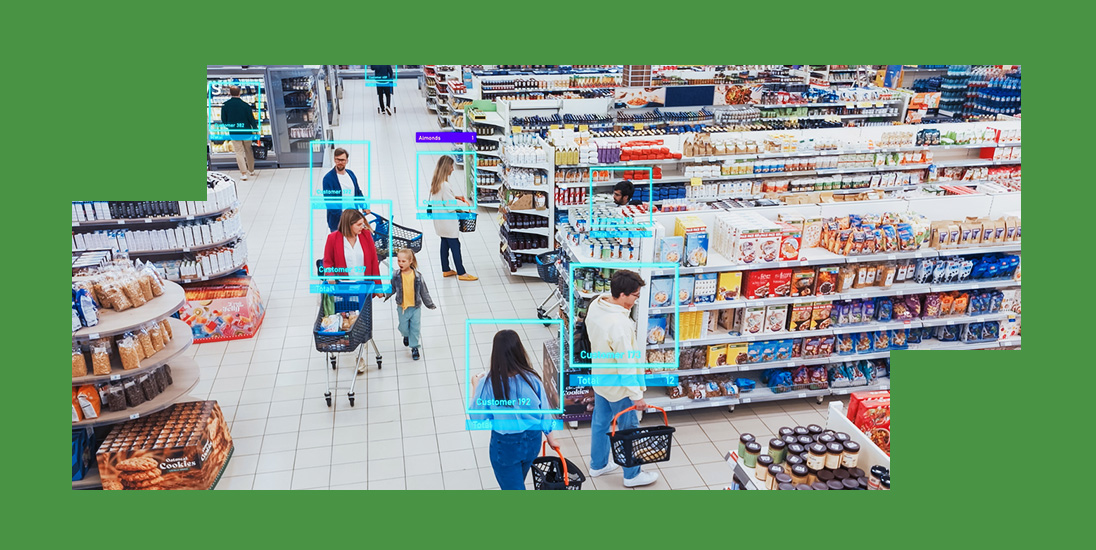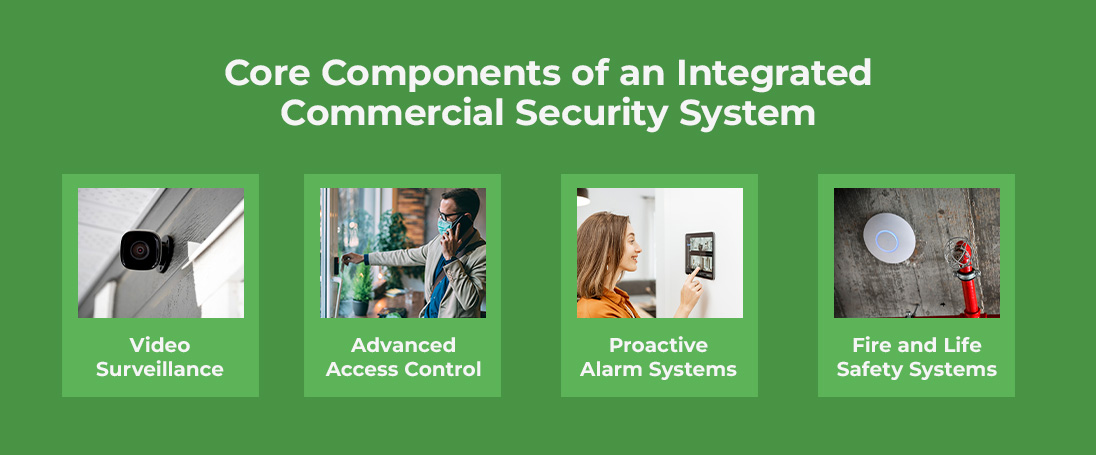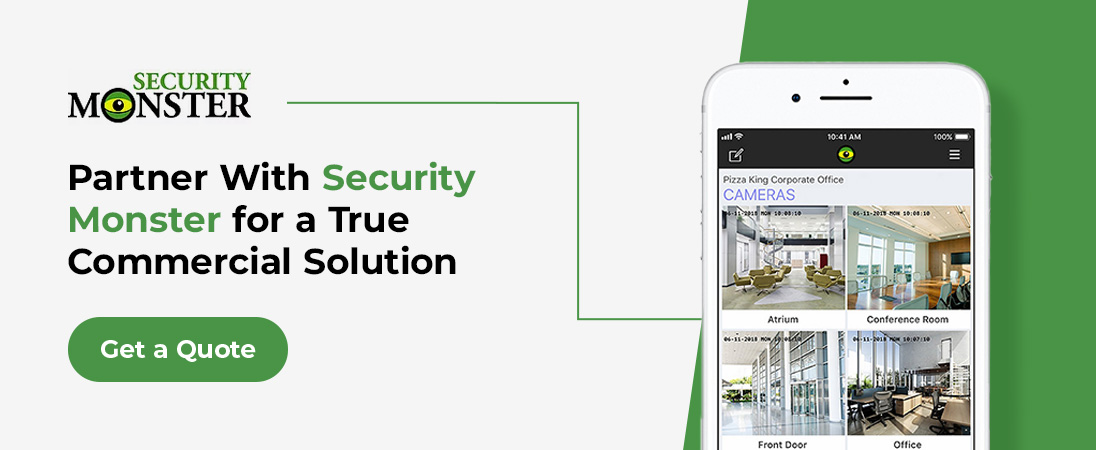Security Devices Integration Strategies for Commercial Properties

When security devices operate independently, you’re often left managing multiple alarms and apps to keep your property safe. A fragmented approach can cause frustration and leave your business vulnerable to blind spots and overlooked threats.
Here, we show you how advanced security system integration can help protect your business.
Unifying Your Security
A unified or integrated system is a single platform that combines multiple security devices on a centralized control panel or dashboard. From access control to fire alarms and video surveillance, all these components work together to provide a comprehensive overview of your security operations.
The primary goal of a single-source integration is to enable all your devices to communicate seamlessly with each other, creating intelligent systems equipped to handle the modern threats to commercial space.
Integration provides contextual data on events, allowing you to gain actionable insights rather than receiving simple alerts. These systems help you transition from a reactive to a proactive security approach, enabling you to analyze potential threats before they impact your business.

Core Components of an Integrated Commercial Security System
Modern security systems need robust capabilities to identify threats and guide the implementation of proactive measures. A powerful integrated system combines various devices, providing a clear overview of your property.
Video Surveillance
Video is a crucial component of any business security system. While legacy video systems simply recorded incidents that could help identify people, modern video solutions include advanced technology that can help you spot potential intruders.
Intelligent video security systems incorporate artificial intelligence (AI) and deep learning search that can sort through footage to identify specific people or vehicles.
Some systems also feature loitering detection and license recognition, which can help your team identify suspicious behavior even in high-traffic zones. Other features you may find also include intrusion notification, which creates a virtual fence around restricted zones. If an individual crosses your buffer zone, the system will notify you immediately.
Advanced Access Control
With advanced access control, you can manage entry into your building and across crucial spaces. These systems offer various access methods to help you find a solution that fits your business needs. Use a solely on-premises option with touchless technology to regain complete control over your data. This option is ideal for teams that work on-site.
But if you want faster set-ups, cloud-based access control will provide precisely that. You can review entry and exit activity from any device, anywhere. Cloud-based solutions provide remote access management, enabling you to grant or revoke access as needed.
To get the best of both systems, consider a hybrid system. You can enjoy the data control capability of an on-premises solution with the scalable and remote management that comes with cloud-based access control.
Proactive Alarm Systems
A proactive alarm system uses different verification methods to minimize false alarms. You can use the access control or video surveillance to confirm activity and take action quickly. With a remote control, these systems allow you to monitor multiple locations seamlessly. You can also add and delete users and arm your commercial property from any location.
Fire and Life Safety Systems
The final component of an effective commercial property security system is life safety alarms. Unlike intruder alarms, these systems are designed to alert you to situations that pose a threat to the lives of your team and those in your building.
Fire and life safety systems can include:
- Commercial smoke detectors: Smoke detectors alert you to a fire, enabling you to act quickly and ensure the safety of your team and property. As part of an integrated system, you can use video to verify the accuracy of the alarm, minimizing false alarms and reducing downtime. You can also find companies that offer 24/7 monitoring, ensuring someone is always watching your business to verify incidents.
- Carbon monoxide (CO) detectors: If you work with natural gases or environments where carbon monoxide buildup is a possibility, your property must have CO detectors. You will need a strategic installation to ensure proper detection. Advanced security platforms include priority chat, which allows you to notify your team of readings in real-time, enhancing employee safety.
Strategic Planning for Seamless Integration
Before integrating your commercial security systems, you will need a clear plan. Proper planning is key to achieving successful integrations for your property.
Assess Your Current Infrastructure and Risks
A system audit begins by evaluating your current assets, vulnerabilities and needs. Your assets refer to everything you need to protect. Once you know what you want to protect, it will be easier to achieve your goal.
If you already have an existing system, evaluate it against your requirements. This audit step can help you identify what you need in a new system.
When considering vulnerabilities, determine which solutions will enhance your overall setup. If you have an advanced surveillance system but outdated access control technology and alarms, then focus on replacing those solutions. Don’t overhaul your entire system if you don’t need to.
Determine the Right System for Your Property
A key tool for implementing system integrations is having the right devices. Off-the-shelf security solutions will not provide adequate protection for your business. These solutions often lack the features required for professional monitoring on your property.
Business needs vary across locations and industries, necessitating a system tailored to the specific business environment. When searching for a security system, ensure it has the capabilities and high performance you need. Professional solutions often come with an installation service that ensures your infrastructure can deliver lasting reliability.
Prioritize Open-Platform Technology
Open-platform technology is the best option for companies looking for flexibility in their security systems. Choosing an open platform means you can integrate devices from different manufacturers onto a single system. An open platform differs from proprietary systems in that it offers you a simpler way to upgrade your security without rigid and often expensive vendor lock-ins.
When designing your system, ensure that you select products that can integrate seamlessly with others. You could also partner with a commercial security contractor who can suggest the best devices tailored to your business.
Develop an Implementation Roadmap
You don’t need to implement system integrations all at once, especially if you don’t have the budget to do so. Our advice is to compartmentalize the process. Determine which components meet your most urgent needs and which can afford to wait and prioritize accordingly. Depending on the threats your business faces, you can postpone the installation of secondary devices.
Partner With Security Monster for a True Commercial Solution
Integrated security systems are a strategic move for your business, providing a comprehensive overview of your security operations. When your business is involved, you don’t need big-box store solutions — you need a personalized approach that ensures you gain visibility across all functions.
At Security Monster, we offer custom commercial solutions backed by 24/7 monitoring. Our advanced cloud systems and advanced technology help keep your team and business protected at any time of day.
Get a free quote and learn how our systems can integrate with yours.

